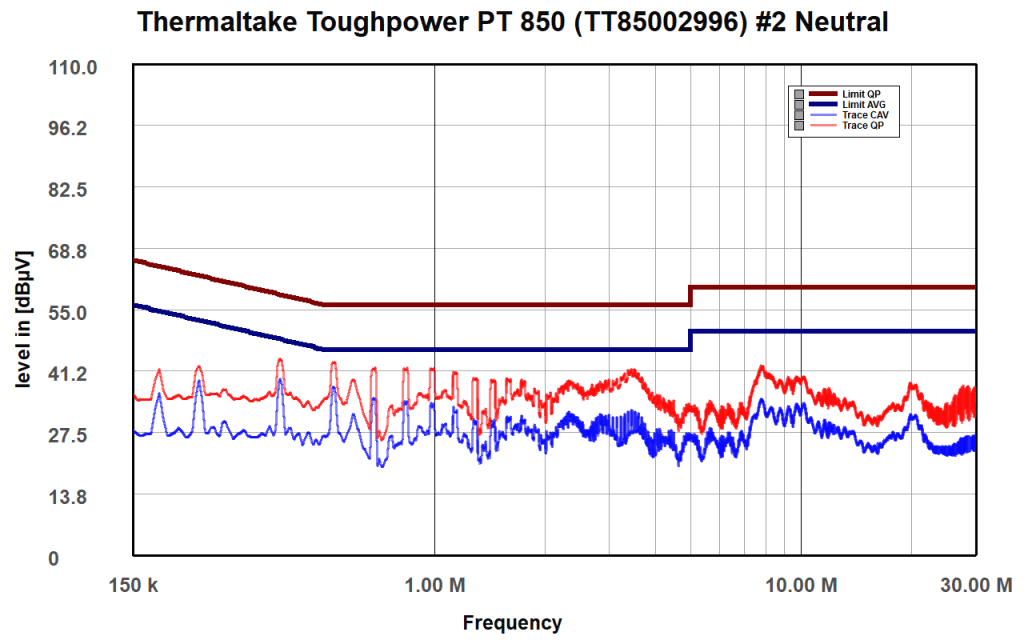Protection Features
Desktop power supply units (PSUs) include several protection features to safeguard both the PSU itself and the connected PC components (motherboard, CPU, GPU, drives, etc.). These protections prevent damage from electrical faults, overloads, or abnormal conditions.
| OCP (Normal @ 31.4°C) | 12V: 89.80A (126.84%), 11.976V 5V: 23.5A (117.50%), 5.018V 3.3V: 24.5A (122.50%), 3.305V 5VSB: 4.6A (153.33%), 4.903V |
| OCP (Hot @ 42.3°C) | 12V: 97.80A (138.14%), 11.971V 5V: 23.5A (117.50%), 5.021V 3.3V: 24.3A (121.50%), 3.309V 5VSB: 4.5A (150.00%), 4.9V |
| OPP (Normal @ 27.6°C) | 1060.50W (124.77%) |
| OPP (Hot @ 40.4°C) | 1050.62W (123.60%) |
| OTP | ✓ (145°C @ Heat Sink) |
| SCP | 12V to Earth: ✓ 5V to Earth: ✓ 3.3V to Earth: ✓ 5VSB to Earth: ✓ -12V to Earth: ✓ |
| PWR_OK | Proper Operation |
| UVP (Full Load @ 90V) | ✓ |
| UVP (No Damage @ 80V) | ✓ |
| Conducted Emissions EN55032 & CISPR 32 | ✓ |
| NLO | ✓ |
| Fan Failure Protection | ✗ |
| SIP | Surge: MOV Inrush: NTC & Bypass Relay |
In the 1200W and 1000W models, the OCP and OPP triggering points were set correctly, but unfortunately, this is not the case for the 850W model. At 12V, OCP at high operating temperatures is set notably higher than at normal temperatures, whereas it should be the other way around. Moreover, the 5V OCP triggering points are similar at both normal and high temperatures, but they are at least conservative. Only at 3.3V is the hot OCP triggering point slightly lower, and thankfully, it is conservative.
Regarding the OPP triggering points, they are too close together between normal and high operating temperatures. There should be a greater difference.
The remaining essential protection features are present and function well, except for fan failure protection, which is not implemented. Manufacturers must quickly realize that fan failure protection is crucial and begin implementing it in their designs.
EMC Pre-Compliance at a Glance
Every electronic device, including PSUs, can be an EMI source, and the amount of EMI it emits can affect the proper operation of nearby devices. EMI can, in some extreme cases, even render them unusable. Some standards have been established to minimize electromagnetic interference (EMI) noise. The corresponding standards for IT (Information Technology) products are CISPR 32 and its derivative, EN 55032, which applies to products sold in the EU. In the EU, every product bearing the “CE” marking must comply with the EN 55032 standard. CISPR 32 and EN 55032 standards categorize devices into two classes: A and B. Class B equipment is intended for domestic environments. Hence, its permitted EMI emissions are significantly lower than those of A-class devices.
Our equipment for EMI readings:
- TBMR-110M EMI-Analyzer DC-110 MHz
- Tekbox TBLC08 LISN
- Tekbox TBFL1 transient limiter
- Tekbox EMCview software
| CISPR 32 / EN55032 Limits | ||
| CISRP 32 / EN 55032 Class A Conducted EMI Limit | ||
| Frequency of Emission (MHz) | Conducted Limit (dBuV) | |
| Quasi-peak | Average | |
| 0.15 – 0.50 | 79 | 66 |
| 0.50 – 30.0 | 73 | 60 |
| CISPR 32 / EN 55032 Class B Conducted EMI Limit | ||
| Frequency of Emission (MHz) | Conducted Limit (dBuV) | |
| Quasi-peak | Average | |
| 0.15 – 0.50 | 66 – 56 | 56 – 46 |
| 0.50 – 5.00 | 56 | 46 |
| 5.00 – 30.00 | 60 | 50 |
| CISRP 32 / EN 55032 Class A 10-Meter Radiated EMI Limit | ||
| Frequency of Emission (MHz) | Field Strength Limit (dBuV/m) | |
| 30 – 88 | 39 | |
| 88 – 216 | 43.5 | |
| 216 – 960 | 46.5 | |
| > 960 | 49.5 | |
| CISRP 32 / EN 55032 Class B 3-Meter Radiated EMI Limit | ||
| Frequency of Emission (MHz) | Field Strength Limit (dBuV/m) | |
| 30 – 88 | 40 | |
| 88 – 216 | 43.5 | |
| 216 – 960 | 46.0 | |
| > 960 | 54.0 | |
Please note that the ATX spec allows a 4 dB margin for conducted and radiated emissions. This means that if a PSU exceeds the limits but stays within the 4 dB margin, it meets the corresponding ATX spec requirement (8.1 Emissions).
EMI Results
The PSU’s EMI emissions are under control.





Will you have a written reviews on the recently released Dark Power 14 models? Thank you for your work on PSUs by the way and sorry for posting it here
I will start them now that I finished the PT series.
Cybenetics reports are up. 🙂